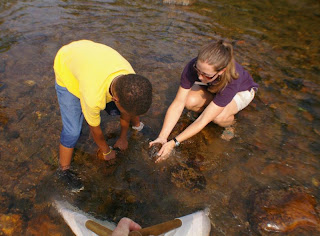Robin Jensen of the Virginia Museum of Natural History and Brian Williams of DRBA had teamed up to teach the kids about the aquatic environment in the Smith River and how water quality and the health of the river can be monitored by the number and variety of macro invertebrates found there.
But first, they had to learn how to catch the "bugs" from the river and learn to identify them. Some were hesitant to enter the water but as the temps climbed, they came to the conclusion that on a hot day the 56 degree water temps were a welcome relief from the heat.
Upon arriving at the site the famous Smith River mist was hanging over the river but was quickly burned away as the temperatures climbed toward the 90's.
The students learned how to use the seine nets to catch the stoneflys, mayflys, crayfish and helgramites that live under the rocks on the bottom of the stream.
Soon they were even using thier smaller nets and working together in teams to catch crayfish and other benthic macro invertebrates that call the Smith home.
Then students then got a chance to view all they had captured up close and using field guides they learned how to identify the variety of aquatic insects and crustaceans..
Quite a few crayfish were discovered and the observant students noticed a large
female caring her eggs under her tail
After returning all the critters to the river, they all had a chance to get out and cool off in the refreshing waters of the Smith before returning to the MuseumSome were still searching for macros as others explored upstream in the deeper waters.
The best learning experiences are when you don't even realize you are learning. Its always fun and amazing to watch a group experiencing the river and gaining an appreciation for the natural resources that everyone must work together to protect. They come away with a better understanding of a delicate ecosystem and the interactions of water quality and aquatic life.... but to them its just fun day on the beating the heat on the river !

























1 comment:
Brian,
I remember, when teaching nature at a summer camp in the NC Appalachians some years back, and giving the kids some cheap magnifying lenses and having them look at dirt. Here in Florida, the dirt is mostly just sand, as you well know, but in the mountains the sand is composed additionally of garnet, sapphires, rubies, coal, mica and many other minerals.
Of course the little boy hellions immediately began setting their shoes and leaves afire, but the exclamations of wonder and awe by the 12yo girls follows me unto this day. It was as much magic for me as it was for them.
What a pity that I didn't have experience with macroinvertebrates yet! Imagine them inspecting mini-monsters using magnifiers.
Post a Comment